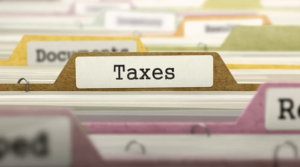How to Calculate Your Estimated Tax Payments
Rebecca Casarez, CPA

What Are Estimated Taxes?
Estimated taxes are tax payments made by self-employed individuals. The IRS requires most of your tax liability to be paid by the due date. W-2 employees, most of the time, can satisfy this requirement by having the relevant taxes withheld from each paycheck, while self-employed individuals and business owners make estimated payments throughout the year.
Do I Need To Pay Estimated Taxes?
If you are self-employed or receive income with no withholdings, you likely need to make estimated tax payments. In addition to self-employment income, receiving income from the following sources requires estimated tax payments:
Investment income – such as from a rental property
Partnership or S co
corporation distributions
Significant retirement
ent distributions (From certain retirement accounts)
Unemployment income where you choose to have no withholdings
It is important to note that if you are a W-2 employee and receive income that has no withholdings, you will need to send estimated tax payments for the non-W-2 income.
What Is A Simple Way to Calculate Estimated Taxes?
If your income is relatively constant year to year, the simplest way to calculate your estimated tax payments is to take the previous year’s tax liability and divide by four. Because your income remains steady each year, the previous year’s tax bill should come very close to this year’s tax bill.
For example, suppose you are a tradesman or skilled laborer whose tax bill for the last four years has been $40,000. In this case, you would take the $40,000 and divide it by four, and make four equal payments of $10,000 to satisfy your tax requirements for this year. If you think you may earn a little more this year, it is a good idea to use 110% of the previous year’s bill, which would be $44,000.

Another Method
If your income varies from year to year, another method to calculate your estimated tax is to use your earnings in the year so far.
For example, suppose you have a skilled labor or tradesman business and you calculate you owe $5,000 for the first estimated payment. You could use the $5,000 as a baseline to calculate your next payment and make any necessary adjustments as you get more information.
When Do I Need To Make Payments?
Estimated taxes are made quarterly. Here is the schedule for 2023.
First payment due – April 18, 2023
Second payment due – June 15, 2023
Third payment due – September 15, 2023
Fourth payment due – January 15, 2024

New Digital Tax Calendar
These dates are not ironclad. Stay up-to-date on tax deadlines with our new digital tax calendar that syncs directly with the calendar tool you already use.
Many taxpayers find it easier to make payments more often. For example, if you are a busy tradesman and prefer making smaller payments more often, you can send tax payments each month.
You will fill out an IRS Form 1040-ES to calculate and pay your estimated taxes. If you are filing for a corporation, you will use form Form 1120-W.
Example
Let’s walk through a detailed example to show the entire process of calculating estimated taxes. Suppose Bob is a self-employed tradesman who uses skilled labor to complete client projects. Bob estimates he will earn $100,000 this year because his income has been around this amount the last five years.
After taking all his deductions, Bob calculates his taxable income at $70,000. Bob next multiplies his taxable income by his marginal tax rate to arrive at his tax liability.
Bob is a single filer, so his marginal tax rate is 22%. $70,000*.22 = $15,400. Bob’s estimated tax liability is $15,400. Bob wants to pay taxes quarterly, so he will send the quarterly IRS payments of $3,850 no later than by the relevant deadlines.
Organization Is Important
Organization is important in all aspects of business, especially so when calculating your estimated tax payments. Updating your books regularly to ensure income and expenses are accurate and current is a great way to take some of the stress out of making quarterly payments.
Staying organized also helps avoid penalties from the IRS for incorrect or late tax payments. Even if you have a refund coming, the IRS can charge you penalties for late or incorrect payments.
Making Proper Estimated Payments Can Smooth Cash Flow
One benefit of making estimated tax payments is that the payments can smooth out your cash flow throughout the year. Making quarterly payments of $2,500 each over the course of the year is likely preferable to making a $10,000 payment by the April tax deadline.
This can be important for a seasonal tradesman or skilled labor business.
Summary
As a busy service-based business owner, you know how busy tax season can get. Hopefully, this article’s discussion has helped clarify how to calculate your estimated tax payments. For more information on taxes be sure to check out our other tax articles!
Disclaimer:
This publication is designed to provide information on federal tax and accounting laws and/or regulations. It is presented with the understanding that the author is not rendering legal or accounting services.
This text is not intended to address every situation that arises or provide specific, strategic tax and/or accounting planning advice. This text should not be used solely to answer tax and/or accounting questions and you should consult additional sources of information, as needed, to determine the solution to tax and/or accounting questions.
This text has been prepared with due diligence. However, the possibility of mechanical or human error does exist and the author accepts no responsibility or liability regarding this material and its use. This text is not intended or written by the practitioner to be used and cannot be used by a taxpayer or tax return preparer, for the purpose of avoiding penalties that may be imposed.
Call To Action (Taxes)
Don't forget to share this post!
Related Articles
Copyright 2023 © ProAdvisor CPA
All Rights Reserved
Privacy Policy – Terms and Conditions
ProAdvisor CPA is an active, registered, & licensed Certified Public Accounting firm that abides by the strict regulations of the State Board of Accountancy.







